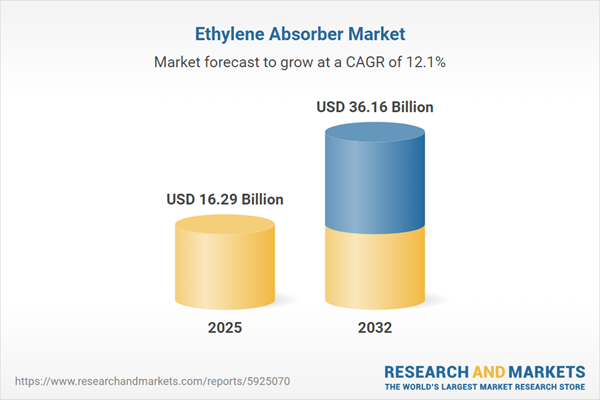Speak directly to the analyst to clarify any post sales queries you may have.
Ethylene absorber technology is increasingly recognized for its role in enabling organizations to optimize supply chain integrity, meet compliance standards, and elevate product quality across diverse markets. By integrating these solutions, senior decision-makers can address operational risks while reinforcing customer confidence and ensuring business continuity.
Market Snapshot: Ethylene Absorber Market Growth and Outlook
The ethylene absorber market is projected to increase from USD 14.51 billion in 2024 to USD 16.29 billion in 2025, with future expansion forecast to reach USD 36.16 billion by 2032. This sustained growth, supported by a compound annual growth rate (CAGR) of 12.08%, is attributed to heightened industry focus on food safety, dependable logistics in perishable goods supply chains, and stringent quality assurance frameworks.
For executives, these technologies serve as critical enablers of transparent, resilient, and compliant supply ecosystems. As consumer preferences evolve and operational demands increase, strategic investment in ethylene absorber technology becomes central to risk mitigation and business performance.Scope & Segmentation: Ethylene Absorber Market
- Sales Channel: Solutions are accessible through convenience stores, specialty retailers, supermarkets, hypermarkets, and online platforms, offering flexible procurement options for varied business sizes and structures.
- Form Factors: Available in forms such as labels, powders, sachets, and trays, ethylene absorbers can be integrated into manual and automated packaging systems, ensuring operational adaptability.
- End Use Industry: High adoption occurs within food and beverage processing, with healthcare and pharmaceutical sectors also implementing solutions to address regulatory requirements and safeguard product integrity.
- Application Areas: Utilized in packaging of fresh produce, dairy, meats, seafood, cut flowers, and vegetables, these solutions reinforce market trust and maintain quality where freshness is critical.
- Material Composition: Core absorbents include activated carbon, clay, silica gel, and zeolite, offering versatility to meet technical safety needs and comply with region-specific regulations.
- Regional Coverage: Adoption trends reflect local policy influence, infrastructure development, and the pace of technology integration throughout the Americas, Europe, Asia-Pacific, and the Middle East and Africa.
- Leading Vendors: Providers such as BASF SE, W. R. Grace & Co., Mitsubishi Gas Chemical Company, Inc., Clariant AG, Ube Industries, Ltd., Imerys S.A., Zeochem AG, Nippon Shokubai Co., Ltd., InterTech Development Co., Inc., and Honeywell International Inc. drive innovation and compliance excellence in the sector.
Key Takeaways for Senior Decision-Makers
- Implementing ethylene absorber technologies within logistics and packaging processes reduces spoilage and aligns operations with rising compliance and quality demands.
- Focus on sustainable material innovation enables organizations to respond effectively to shifting regulatory pressures and sustainability expectations.
- Adoption of sensor-based and real-time monitoring systems improves supply chain transparency and empowers earlier detection of potential quality issues.
- Collaborative supplier engagement and strategic technology partnerships support customized, sector-specific applications that reflect both operational and regulatory priorities.
- Ability to adapt ethylene absorber strategies to diverse regulatory landscapes and infrastructure levels strengthens organizational resilience and product consistency in global operations.
- Investing in advanced, client-oriented ethylene absorber solutions enhances customer satisfaction and positions organizations to perform reliably in sensitive markets.
Tariff Impact on Strategic Sourcing and Cost Structures
With anticipated tariff changes in 2025, procurement leaders expect price variability in core inputs such as activated carbon, silica gel, and specialty zeolites. To prepare, organizations are diversifying supplier networks and establishing new alliances to maintain sourcing reliability. Optimized logistics and procurement initiatives also contribute to cost stability, ensure compliance, and secure supply across complex international markets.
Methodology & Data Sources
This assessment is based on direct interviews with experts in material science, packaging engineering, and supply chain management. Independent validation through current technical literature and patent datasets provides an objective, actionable market perspective.
Why This Report Matters for the Ethylene Absorber Market
- Empowers leadership to synchronize technology investments and supply chain strategies with changing regulatory and environmental conditions.
- Enables rigorous evaluation of ethylene absorber solutions for compliance with industry-specific and sustainability standards.
- Prepares organizations to recognize new opportunities and respond to evolving global market shifts with clarity and speed.
Conclusion
Ethylene absorber technology is instrumental in delivering operational stability and protecting product quality. By leveraging strategic partnership and informed deployment, organizations achieve secure supply chains and maintain lasting customer value.
Additional Product Information:
- Purchase of this report includes 1 year online access with quarterly updates.
- This report can be updated on request. Please contact our Customer Experience team using the Ask a Question widget on our website.
Table of Contents
3. Executive Summary
4. Market Overview
7. Cumulative Impact of Artificial Intelligence 2025
Companies Mentioned
The companies profiled in this Ethylene Absorber market report include:- BASF SE
- W. R. Grace & Co.
- Mitsubishi Gas Chemical Company, Inc.
- Clariant AG
- Ube Industries, Ltd.
- Imerys S.A.
- Zeochem AG
- Nippon Shokubai Co., Ltd.
- InterTech Development Co., Inc.
- Honeywell International Inc.
Table Information
| Report Attribute | Details |
|---|---|
| No. of Pages | 183 |
| Published | November 2025 |
| Forecast Period | 2025 - 2032 |
| Estimated Market Value ( USD | $ 16.29 Billion |
| Forecasted Market Value ( USD | $ 36.16 Billion |
| Compound Annual Growth Rate | 12.0% |
| Regions Covered | Global |
| No. of Companies Mentioned | 11 |









